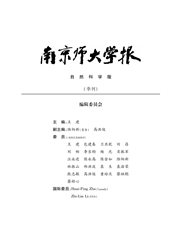

 中文摘要:
中文摘要:
合成了新型配体N-异丙基-2-苯基苯并咪唑(bi)和N-异丙基-2-(4-氟苯基)苯并咪唑(fbi),并用它们与三氯化铱和乙酰丙酮反应,制备了相应的环金属铱(Ⅲ)配合物发光材料(bi):Ir(acac)和(fbi):Ir(acac)(acac=乙酰丙酮).对其结构用。HNMR和元素分析方法进行了表征,研究了配合物的UV-vis,荧光光谱及电化学性质.两种材料的最大发光波长分别位于514nm和493nm.电化学研究表明,在苯环上引入氟原子后,配合物的HOMO和LUMO间能隙增大(分别为0.12eV和0.15eV),与最大发光波长蓝移结果吻合.
 英文摘要:
英文摘要:
New ligands N-isopropyl-2-phenyl-1H-benzoimidazole and N-isoprop-yl-2- ( 4-fluorophenyl ) -1 H-benzoimid- azole were prepared, and their corresponding cyclometalated complexes ( bi ) 2 Ir ( acac ) and (Ⅲ ) 2 Ir ( acac ) ( acac = acetylacetone) were synthesized by the reaction of these two ligands with IrC13and acetylacetone. The structures of the complexes were characterized by I H NMR and elemental analyses. The UV-vis and photoluminescence (PL) spectra were determined, and the electrochemical behaviors of the complexes were studied. The complexes had strong photolumi- nescence in dichloromethane at 514 nm and 493 nm, respectively. The electrochemical study showed that the energy gap between the HOMO and LUMO was enlarged by introducing fluorine on the benzene ring (0. 13 and 0. 15 eV respectively for two complexes) , which was in accordance with the blue shift of the maximum emission wavelength.
 同期刊论文项目
同期刊论文项目
 同项目期刊论文
同项目期刊论文
 The study on the interaction between Tb(III) and ligand in Tb-acetylsalicylic acid complex and fluor
The study on the interaction between Tb(III) and ligand in Tb-acetylsalicylic acid complex and fluor Highly efficient white organic light-emitting diodes based on broad excimer emission of iridium comp
Highly efficient white organic light-emitting diodes based on broad excimer emission of iridium comp Highly efficient organic light-emitting diodes (OLEDs) based on an iridium complex with rigid cyclom
Highly efficient organic light-emitting diodes (OLEDs) based on an iridium complex with rigid cyclom Impact of substituents in the (NN)-N-boolean AND ligand on the emission wavelength of Cu(I) complexe
Impact of substituents in the (NN)-N-boolean AND ligand on the emission wavelength of Cu(I) complexe Iridium(III) complexes with cyclometalated styrylbenzoimidazole ligands: Synthesis, electrochemistry
Iridium(III) complexes with cyclometalated styrylbenzoimidazole ligands: Synthesis, electrochemistry In-situ Apparent Mobility of Charge Carriers in Polyaniline Films Measured with a New Four-band Elec
In-situ Apparent Mobility of Charge Carriers in Polyaniline Films Measured with a New Four-band Elec High-efficient phosphorescent iridium(III) complexes with benzimidazole ligand for organic light-emi
High-efficient phosphorescent iridium(III) complexes with benzimidazole ligand for organic light-emi Synthesis and luminescent properties of Ir complexes with fluorine substituted phenylpyridine deriva
Synthesis and luminescent properties of Ir complexes with fluorine substituted phenylpyridine deriva Synthesis and electroluminescent properties of Ir complexes with benzo[c] acridine or 5,6-dihydro-be
Synthesis and electroluminescent properties of Ir complexes with benzo[c] acridine or 5,6-dihydro-be Influence of electrochemical doping on low frequency noise of conducting poly(3-methylthiophene) fil
Influence of electrochemical doping on low frequency noise of conducting poly(3-methylthiophene) fil Impact of substituents in the N∧N ligand on the emission wavelength of Cu(I) complexes: Insight from
Impact of substituents in the N∧N ligand on the emission wavelength of Cu(I) complexes: Insight from Optical properties of a series of monosilylene–oligothienylene copolymers and the application to lig
Optical properties of a series of monosilylene–oligothienylene copolymers and the application to lig Synthesis, characterization, and electroluminescent properties of iridium complex containing 4-pheny
Synthesis, characterization, and electroluminescent properties of iridium complex containing 4-pheny 期刊信息
期刊信息
